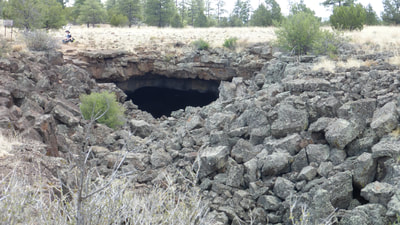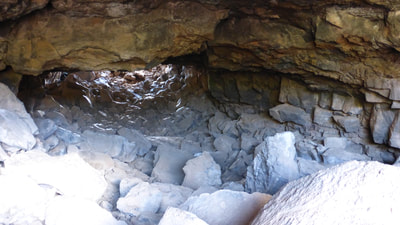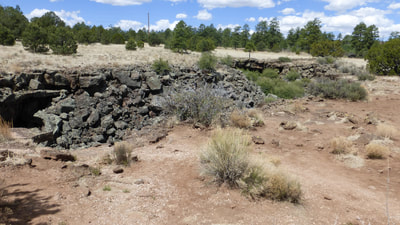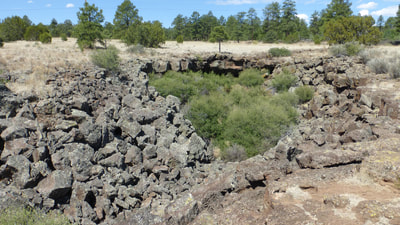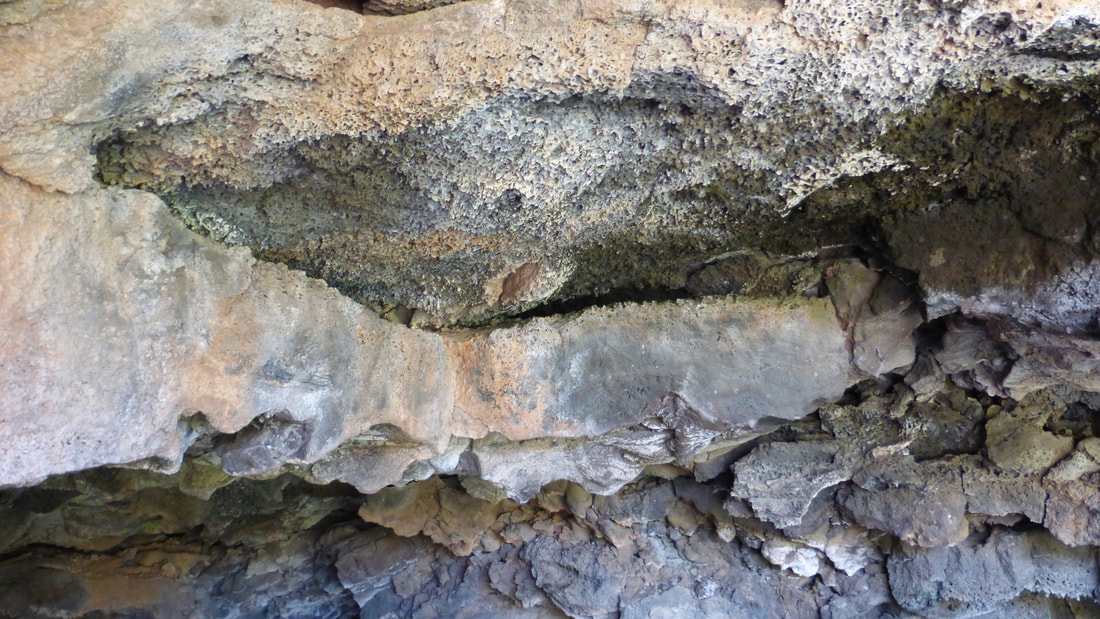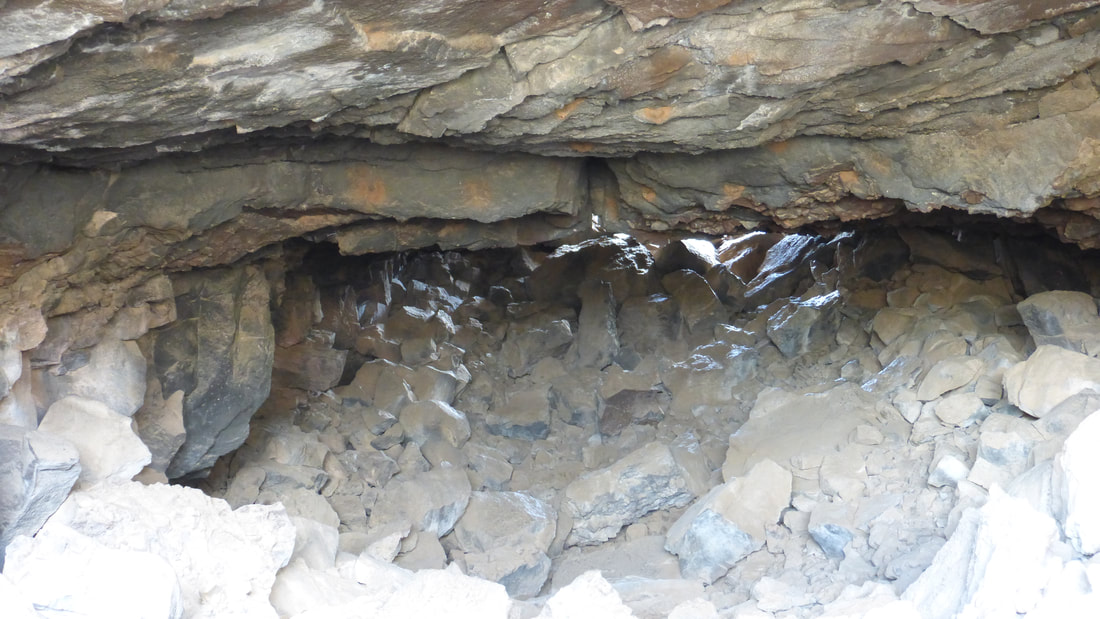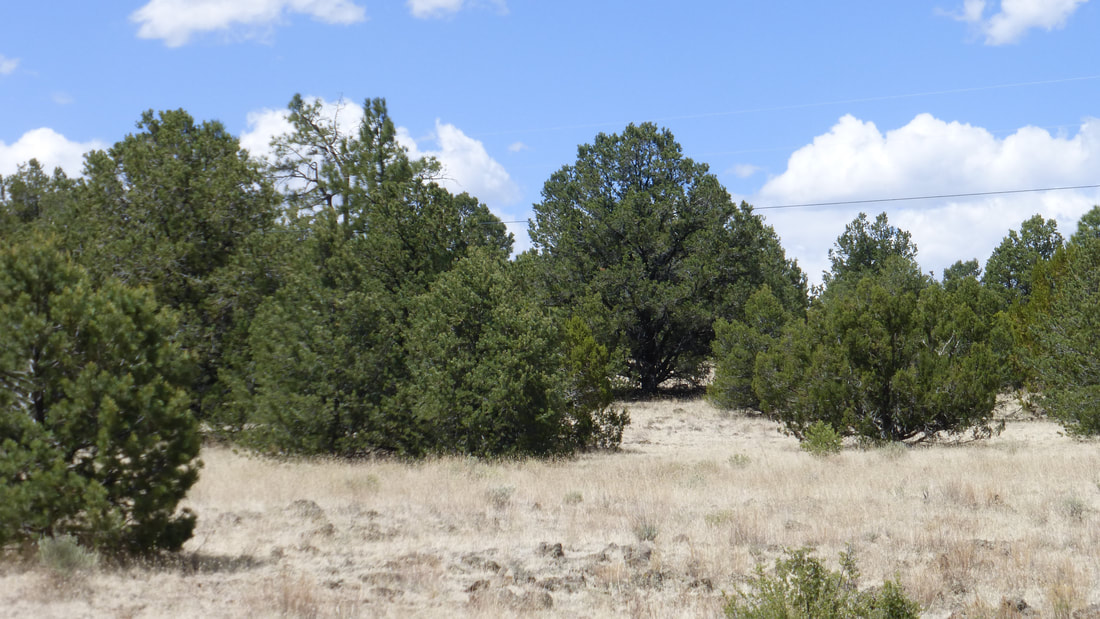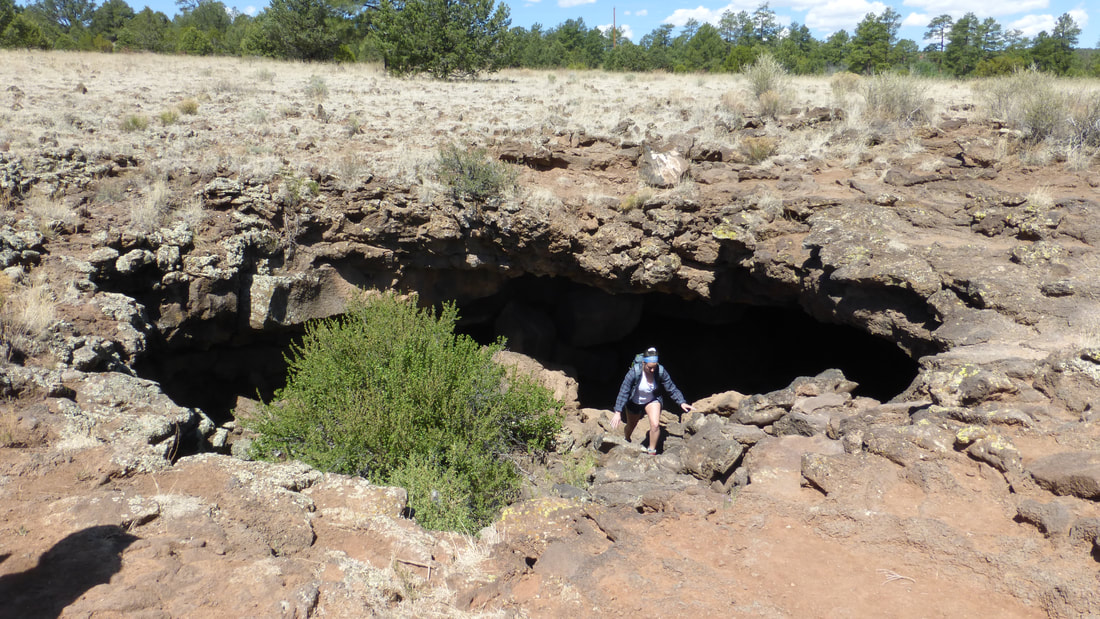On a seemingly mundane plain of dry grass and scattered conifers, there is an elongated pit that reveals the ground below as old cooled lava. The interior of the pit is a jumble of black basalt blocks, and its edges are short drops down vertically-fractured edges of the same rock, capped by mere inches/centimeters of crumbly soil. At either end of the pit there are openings to naturally roofed-over tunnels, showing that this is part of a longer cave-like feature within the lava, a lava tube. One tunnel entrance is quite large, easily explored, with dim daylight glowing at its far end.
Dimensions The pit is 170 ft (50 m) long and 40 ft (12 m) across, running in a broad curve. The jumbled block surface within it sags as much as 15 ft (5 m) below the level of surrounding turf. Most of the basalt blocks are 1-4 ft (0.3-1.2 m) across. The large roofed-over lava tube segment is about 30 ft (10 m) wide, with 10-15 ft (3-5 m) of space between floor and ceiling, and extends 130 ft (40 m).
Key Details
- Lava tubes are formed when lava flows are actively spreading across the landscape. As an individual stream of molten rock begins to cool, the first part to solidify is on its top surface, sides, and base, where it is in direct contact with cool air and ground. The lava deeper within the flow stays liquid much longer, insulated by its hardening outer shell, continuing to rush further downhill to the advancing lava flow front. When the volcanic source abates or its output of lava switches off in another direction, liquid lava evacuates the hardened tube of basalt, leaving it as an air-filled passage. These lava tubes often remain empty as later lava flows accumulate next to them and over them, leaving them as cave-like features within a broad area of built-up lava.
- This lava tube and its surrounding flows are a hundred thousand years old. Most of the lava flows that make up a patchwork thickly covering this region are tens of thousands of years in age, and some are even younger, looking much fresher with bare, shiny basalt surfaces marked by folds and cracks.
- In this spot, the ceiling of the empty, cooled lava tube was thin enough that it could not bear its own weight, and collapsed.
- As lava rock cools down, it contracts, causing vertical cracks that connect in a honeycomb-like network on the ground surface. At this location the cracks were spaced 1-4 ft (0.3-1.2 m) apart, so that the collapsing roof of basalt broke up almost entirely into blocks of that size. These blocks fill the bottom of the collapse pit, and also have spread into the lava tube opening, covering its floor less thickly.
- There is some variation in the feel of the different block surfaces. Most are quite smooth, with slight undulations on the almost-flat surfaces, and sharp corners where the sides meet. Less commonly, some of the basalt block edges are irregularly broken off. A few block faces have a very rough, almost frozen-froth texture of about pea-sized bubble cavities clustered in thin layers. Where breaks have happened along these zones of trapped gas in the cooled lava, the thin rock partitions between bubbles can be sharp and abrasive, liable to give a deep scrape on bare skin if fallen against. These same variations of rock surface texture show in the walls and ceiling of the lava tube (the frothy texture appearing in part of the latter).
- In this high near-desert environment, winters and nights throughout the year are very cold, and not far below the ground surface, rock stays at about mean annual temperature. The lowest part of the lava tube floor, well in from the large entrance, has a pool of cool air (temperature lower by least 20 degrees F, 10 degrees C) that remains so throughout hot days. It is about 3-6 feet (1-2 m) deep, so easy for a person to duck entirely into. Elsewhere in the region, some deeper lava tubes preserve permanent deposits of ice on their floors.
- With very little soil or fine rock debris available to become packed between the fallen rock blocks, they remain as loose piles, and individual blocks may shift and tip if stepped on off-center. Empty spaces between blocks can catch feet and the ends of walking sticks.
- The patchy dry grass is tall enough to hide small lizards and ground squirrels nearby, and the evergreen trees host a variety of small birds. Larger animals sometimes seen in this region include deer, rattlesnakes, bobcats, coyotes, and pumas.
- At the far end of the lava tube passage, there is a smaller, circular collapse pit connecting to the ground surface. A ramp of collapse blocks provides a relatively easy clamber to/from ground level here, as it does at the opposite entrance.
- The lava tube continues in either direction beyond the segment connecting the two collapse pits, but these entrances are smaller, more filled with jumbled blocks. Lava tubes can stretch for thousands of feet/meters, or even miles/kilometers, in fairly linear traces beneath the ground surface.
Story Elements
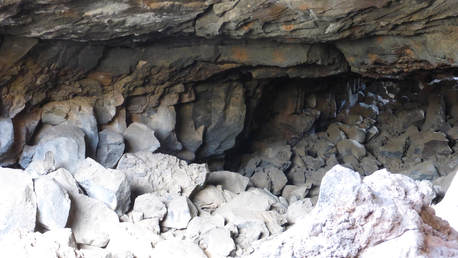
- The lava tube might become a place to hide out during a dust storm, possibly found by chance in near-zero visibility.
- Although local children might typically be warned away from exploring the rough ground of area's collapse pits, a lava tube might become a refuge on a blistering hot day, providing deep shade and a chance to 'wade' in a patch of cool air.
- A lava tube might simply be a place to find some sense of solitude and containment in an otherwise open landscape.
- Does the striking difference of ground appearance and character, between the even turf-covered plain and the chaotic collapse pits, match something else in the story situation? Does it mirror contrasts of different people in the story, or within one person?
- People living in the area might use the collapse pits as sources of rough building stone. In making walls or other structures, they might use the unusual textures of some block faces as decorative or functional elements.
- For someone being sought by enemies (or rescuers), the block-filled collapse trench might be a significant obstacle to direct approach. The jumbled, angular boulders would present difficult terrain for those on foot, and entirely forbid crossing on horseback or by wheeled vehicles. In the time pursuers would take to circle around the trench, a fleeing person might have time to move back among the trees, or stay out of easy reach by moving down into the pit.
- There are a few places within the lava tube, rough wall indentations or spaces between large collapse blocks, where a person might hide, especially from viewers at the entrances.
- If a pursuer is not aware of the other exit of the lava tube (more likely at night), it can provide an avenue of escape, or a chance for the quarry to re-approach from behind/above.
- Why did the light from one end of this lava tube passage just go out? Is it the shadow of something very large moving over the ground or air above, or possibly some large thing with us in the tube, that has just silently shifted?
- Because of the lack of smaller stones and soil between the basalt blocks, the pile of debris in a pit has a network of small, clear passages between the blocks. This sheltered below-ground space might be the nesting ground of a population of small creatures that might flood into view at a particular time of day, or with some disturbing event.
- A sorcerer or magic creature that draws strength from the earth might find heightened powers while situated in the interior of the lava tube, volcanic bedrock being close above and to every side as well as below.
Reference Location
El Calderon trail head, El Malpais National Monument, near Grants, New Mexico. These collapse pits are on the trail 200 ft (60 m) south of the parking lot, which has pit toilet and no running water. More lava tube collapse pits, longer trenches, and lava tube entrances are on the trail 1200 ft (360 m) further south, and a cinder cone can also be reached on this hike. Visitors wishing to explore lava tubes should register with park staff.
© Rice-Snows 2017
Proudly powered by Weebly
